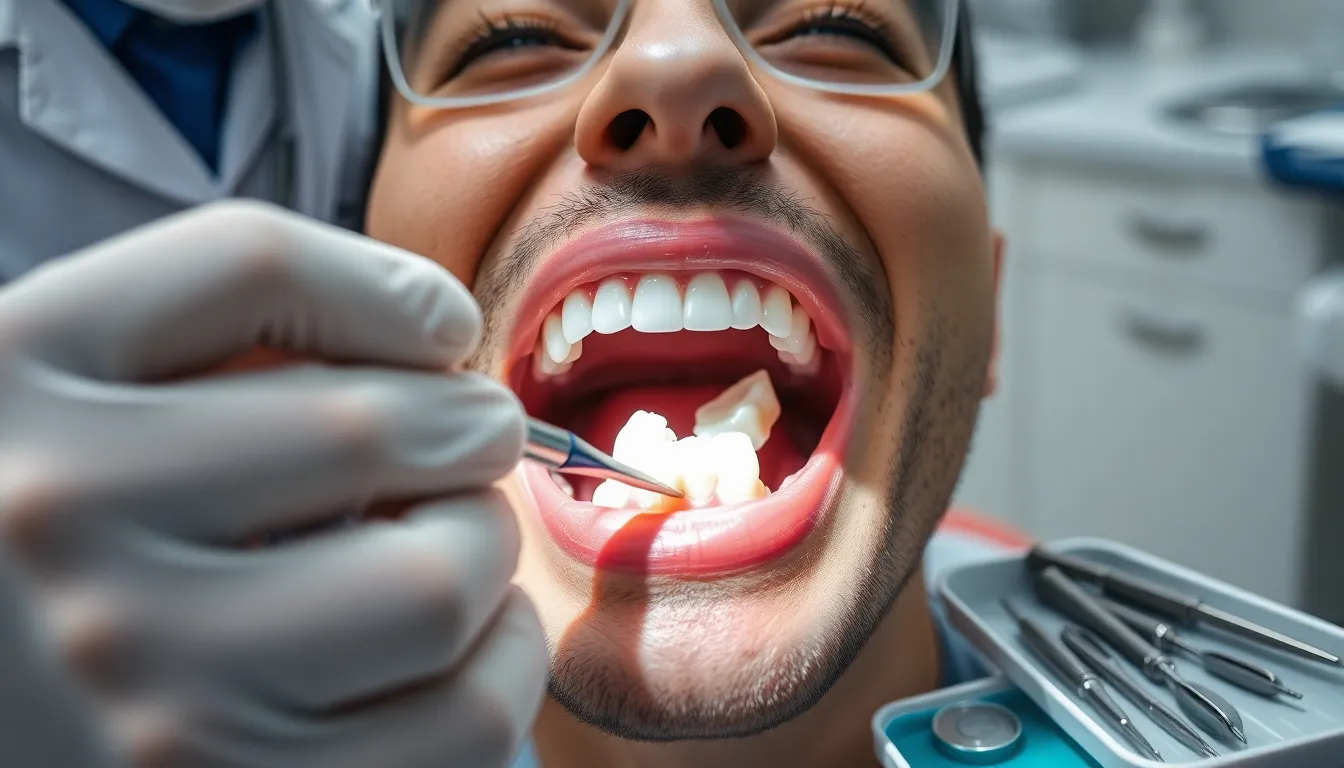Can a dentist repair a broken tooth? Absolutely—and understanding your options could be the difference between saving or losing your damaged tooth.
When disaster strikes and you’re left with a broken tooth, it’s natural to feel panicked. Whether from a sports injury, biting down on something hard, or general tooth decay, dental fractures can happen to anyone at any time. The good news is that modern dentistry offers several effective answers for repairing broken teeth, from simple bonding procedures to more comprehensive treatments like crowns and veneers.
Your dentist has the expertise and tools to evaluate the extent of the damage and recommend the most appropriate treatment to restore both function and appearance. The exact repair method will depend on the severity of the break, the location of the tooth, and your overall oral health.
Understanding Broken Teeth: Types and Causes
Broken teeth represent one of the most common dental emergencies that dentists treat daily. Dental fractures vary significantly in severity and type, with each requiring exact treatment approaches to restore function and appearance.
Common Ways Teeth Break
Teeth break for many reasons, ranging from sudden impacts to gradual wear. Biting down on hard foods like ice, popcorn kernels, or candy can cause immediate fractures. Sports injuries account for many dental emergencies, particularly in contact sports where protective mouthguards aren’t worn. Teeth grinding (bruxism) creates microfractures that eventually lead to larger breaks over time. Untreated decay weakens tooth structure from the inside out, making teeth susceptible to breaking even during normal chewing. Car accidents and falls frequently result in dental trauma, especially affecting front teeth.
Dr. Harris recalls treating a patient named Michael who broke his front tooth biting into an olive with a pit. “What seemed like a harmless snack led to a important dental emergency. This case reminds me to always emphasize to patients that teeth aren’t tools—they’re invaluable structures designed specifically for certain foods and functions.”
Assessing the Severity of Tooth Damage
Dental professionals categorize tooth fractures based on several distinct classifications. Craze lines appear as tiny cracks in the enamel that typically don’t cause pain and require no treatment. Fractured cusps involve breaks in the chewing surface and rarely affect the pulp, making them relatively straightforward to repair. Cracked teeth extend from the chewing surface toward the root but haven’t yet separated into pieces, requiring prompt attention to prevent further damage. Split teeth have cracks that extend through both cusps and deep into the root, often necessitating extraction if the crack extends below the gumline. Vertical root fractures begin in the root and extend upward, frequently remaining undetected until infection develops.
The location of the break significantly impacts treatment options and prognosis. Fractures extending below the gumline present more complex challenges than those limited to the crown portion. Symptoms like pain when chewing, sensitivity to temperature, or discomfort when releasing biting pressure indicate potential pulp involvement. Discoloration of the fractured tooth often suggests internal bleeding or nerve damage that requires root canal therapy before cosmetic repair.
Can a Dentist Repair a Broken Tooth?

Yes, dentists can repair broken or chipped teeth through multiple restorative procedures. These treatments range from simple dental bonding for minor chips to more complex answers like crowns, root canals, or implants for severe damage. Modern dentistry offers effective answers for nearly any type of dental fracture.
Evaluating If Your Broken Tooth Is Repairable
The repairability of your broken tooth depends on the severity and location of the damage. Minor chips or cracks typically respond well to dental bonding treatments using tooth-colored resin that’s shaped and hardened with ultraviolet light—a quick, often painless procedure requiring no anesthesia in most cases. Larger breaks may necessitate crowns or veneers to restore both function and appearance. Crowns completely cover and protect the damaged tooth, while veneers offer cosmetic improvement through thin shells bonded to the tooth surface. Damage extending to the nerve or root often requires a root canal before crown placement to preserve the tooth. Severe fractures below the gumline or affecting the root might require extraction followed by replacement options such as dental implants or bridges.
Dr. Todd B. Harris notes, “I’ve seen patients devastated by a broken tooth who leave our office smiling after treatment. One patient came in with a fractured front tooth from a cycling accident—she was certain she’d need it extracted. Using a combination of bonding and a porcelain veneer, we restored both function and aesthetics, completely transforming her confidence.”
When Immediate Dental Care Is Necessary
Immediate dental attention becomes critical in several scenarios involving broken teeth. Knocked-out teeth require action within 30 minutes for successful reimplantation—place the tooth back in its socket if possible or store it in milk or your mouth to keep it moist while seeking emergency care. Breaks causing pain, bleeding, or exposing the dental pulp demand prompt evaluation to prevent infection and further complications. Severe fractures with sharp edges can damage soft tissues in your mouth, creating additional problems if not addressed quickly. Fragments of a broken tooth might also create choking hazards or cause injury to the tongue and cheeks. Delaying treatment for broken teeth increases risks of infection, nerve damage, and potentially more invasive and expensive procedures down the road. Emergency dental care improves treatment outcomes significantly and helps preserve your natural tooth structure whenever possible.
Treatment Options for Broken Teeth

Modern dentistry offers several effective answers for repairing broken teeth, with treatments customized to the exact type and extent of damage. Your dentist can recommend the most appropriate option after a thorough examination of the affected tooth.
Dental Bonding for Minor Chips
Dental bonding provides a quick and effective solution for minor chips and small cracks in teeth. During this procedure, your dentist roughens the tooth surface, applies a conditioning liquid, and molds a tooth-colored composite resin to the damaged area. The resin is hardened using an ultraviolet light, then shaped and polished to blend seamlessly with your natural tooth. Patients appreciate bonding for its affordability, with results lasting up to 10 years with proper oral hygiene. Dr. Todd B. Harris notes, “Many of my patients are surprised by how groundbreaking a simple bonding procedure can be—often completed in just one visit without the need for anesthesia.”
Dental Crowns for Substantial Breaks
Dental crowns become necessary when teeth suffer important breaks or structural weakening. These tooth-shaped caps completely cover the damaged tooth, restoring both function and appearance. Your dentist prepares the tooth by removing any decayed or damaged portions, shapes the remaining structure, and fits the custom crown over it. Crowns protect vulnerable teeth from further damage while providing full chewing functionality. They’re particularly valuable for protecting teeth that have undergone root canal therapy. Made from materials like porcelain, metal alloys, or ceramic, crowns offer durability and natural aesthetics that can last 15+ years.
Veneers for Cosmetic Restoration
Veneers offer an excellent cosmetic solution for front teeth with visible chips or cracks. These thin, custom-made shells attach to the front surface of teeth, instantly improving their appearance. Your dentist removes a small amount of enamel, takes precise impressions, and bonds the porcelain or composite resin veneer using special light-cured cement. Patients seeking a smile makeover often choose veneers for their stain resistance and natural look. One patient shared, “After breaking my front tooth in a biking accident, I was devastated—until my dentist suggested a veneer. Now my smile looks better than before the accident!”
Root Canal Therapy for Deeper Damage
Root canal therapy becomes essential when breaks expose the tooth’s pulp, allowing bacteria to cause infection. This procedure involves removing the infected pulp tissue, cleaning the inner canals, and sealing them to prevent further infection. Your dentist typically places a crown afterward to protect the treated tooth from fracturing. Even though their reputation, modern root canal procedures are generally no more uncomfortable than having a filling placed. Dr. Harris emphasizes to patients, “Root canal therapy isn’t something to fear—it’s actually the solution that relieves pain and saves teeth that might otherwise require extraction.” This treatment preserves your natural tooth structure while eliminating the source of infection and discomfort.
The Broken Tooth Repair Process

Dentists use several effective procedures to repair broken teeth depending on the severity and location of the damage. The treatment approach varies from simple bonding for minor chips to more complex answers for extensive damage.
Dental Bonding
Dental bonding offers a quick solution for minor chips and small breaks in your teeth. Your dentist first prepares the tooth surface with an etching gel to create tiny roughened areas, helping the bonding material adhere properly. Next, they apply a tooth-colored composite resin to the damaged area, shape it to match your natural tooth structure, and harden it using ultraviolet light. This painless procedure rarely requires anesthesia and typically takes 30-60 minutes to complete. Bonded repairs can last up to 10 years with proper care and cost significantly less than other restoration options.
Dental Crowns
Crowns provide durable protection for teeth with larger fractures or extensive damage. These custom-made caps cover the entire visible portion of your tooth, restoring its strength, shape, and appearance. Your dentist prepares the damaged tooth by removing a small amount of enamel, takes precise impressions, and places a temporary crown while your permanent one is fabricated in a dental laboratory. The final crown—made from porcelain, ceramic, metal, or a combination—is cemented in place during a second appointment, creating a strong, natural-looking restoration that can last 15+ years.
Root Canal Therapy
Root canal treatment becomes necessary when a break extends into the tooth’s pulp or nerve chamber. During this procedure, your dentist creates a small access hole in the tooth, removes the infected or damaged pulp tissue, cleans the canal system, and fills it with a biocompatible material. The tooth is then sealed and typically reinforced with a crown to prevent further damage. While root canals have a reputation for being painful, modern techniques and anesthetics make them no more uncomfortable than getting a filling. Dr. Todd Harris often reminds patients, “Today’s root canal procedures focus on preserving your natural tooth while eliminating pain, not causing it.”
What to Expect During Your Dental Visit
Your broken tooth repair appointment begins with a comprehensive examination to assess the extent of damage. The dentist takes digital X-rays to evaluate the depth of the break and checks for any nerve involvement or infection. Based on this assessment, they’ll discuss treatment options and develop a personalized repair plan. For bonding or fillings, you’ll likely complete treatment in a single visit without anesthesia. Crown procedures require tooth preparation and impressions during the first visit, followed by placement at a second appointment. Root canal treatments may involve 1-2 visits depending on complexity, with local anesthesia ensuring your comfort throughout the procedure.
Cost of Repairing a Broken Tooth

The cost of repairing a broken tooth varies significantly depending on the severity of damage and treatment method chosen. Dental expenses for tooth repairs range from relatively affordable to more substantial investments based on the complexity of the procedure.
Insurance Coverage for Broken Tooth Repairs
Dental insurance typically covers restorative treatments for broken teeth, including fillings and crowns, as these are considered medically necessary procedures. Coverage percentages often follow the standard 100-80-50 structure, with insurance paying 100% for preventive care, 80% for basic procedures like fillings, and 50% for major treatments such as crowns. Cosmetic treatments like veneers may not receive coverage since insurance providers classify them as elective procedures. Your exact benefits depend entirely on your individual plan’s terms, so contacting your insurance provider before treatment helps avoid unexpected out-of-pocket expenses.
One patient, Sarah, discovered her insurance covered 80% of her dental bonding procedure for a chipped front tooth, but would only cover 50% of a crown she needed for a more severely broken molar—highlighting the importance of understanding your exact coverage limitations.
Financing Options for Dental Treatments
Many dental practices offer payment plans that allow you to spread the cost of treatment over several months without interest. Third-party financing companies provide specialized loans or credit lines specifically for dental care, making treatments more accessible regardless of insurance coverage. CareCredit functions as a healthcare credit card accepted by many dental providers, offering promotional periods with zero interest if paid within the specified timeframe. Some dental offices participate in membership plans that provide discounts on various procedures for a monthly or annual fee, creating an alternative for patients without traditional insurance.
Preventing Future Tooth Damage

After repairing a broken tooth, taking steps to prevent future damage becomes essential for maintaining your restored smile. Preventive measures protect both your natural teeth and any dental restorations you’ve received.
Protective Measures for At-Risk Teeth
Athletic mouthguards provide crucial protection during sports activities, significantly reducing your risk of dental trauma. Custom-fitted guards from your dentist offer superior protection compared to over-the-counter options. Avoiding biting or chewing hard objects like ice, popcorn kernels, and hard candies helps preserve tooth integrity and prevents unnecessary stress on your dental work.
Regular dental check-ups every six months allow your dentist to identify early signs of cracks or weakening before they develop into major problems. Maintaining excellent oral hygiene through daily brushing and flossing removes plaque that can weaken teeth and compromise restorations. Night guards effectively protect teeth for patients who grind or clench during sleep, a condition many patients don’t realize they have until their dentist identifies the telltale wear patterns.
Dr. Todd B. Harris recalls a patient named Michael who broke a molar while biting into an unpopped popcorn kernel during a movie. “After we restored his tooth with a crown, Michael committed to wearing a custom mouthguard during his weekend basketball games and stopped chewing ice completely. Five years later, his restoration remains intact, demonstrating how simple preventive measures can protect your dental investment.”
Addressing acidic food consumption also plays a role in prevention. Frequent exposure to acidic foods and beverages can erode dental enamel, making teeth more susceptible to breaks. Rinsing your mouth with water after consuming acidic items helps neutralize their effects without abrading softened enamel.
Conclusion
Broken teeth don’t have to be permanent problems thanks to modern dentistry. Your dentist has multiple tools to address dental fractures from simple bonding to comprehensive crowns and root canal treatments. The right solution depends on your exact situation and damage severity.
Treatment costs vary but insurance typically helps cover restorative procedures. Many dental offices also offer financing options to make repairs more accessible.
Remember that protecting your repaired tooth is just as important as fixing it initially. Preventive measures like mouthguards for sports and avoiding hard foods can help maintain your restored smile for years to come.
Don’t delay seeking treatment if you experience a broken tooth—prompt attention provides the best chance for successful repair and preserving your natural tooth.
Frequently Asked Questions
What causes a tooth to break?
Teeth can break due to various factors including sudden impacts (sports injuries, falls), biting hard foods (ice, nuts, candy), tooth decay weakening tooth structure, teeth grinding (bruxism), and gradual wear over time. Untreated cavities often lead to weakened teeth that are more susceptible to fractures. Even seemingly harmless habits like chewing on pens or using teeth as tools can contribute to dental fractures.
How do I know if my broken tooth is an emergency?
Seek immediate dental care if you experience severe pain, significant bleeding, a completely knocked-out tooth, or sharp fragments that could injure your mouth. Other emergency signs include extreme sensitivity to temperature, visible exposure of the tooth’s nerve, or infection symptoms like swelling and fever. Even if pain is minimal, schedule an appointment within 1-2 days to prevent complications like infection or further damage.
What are the treatment options for a chipped tooth?
Treatment options depend on chip severity. Minor chips may require simple dental bonding using tooth-colored composite resin. More substantial damage might need veneers (thin porcelain shells) or crowns (caps that cover the entire tooth). Very severe chips exposing the pulp may require root canal therapy before restoration. Your dentist will recommend the most appropriate solution based on the extent of damage.
How long does dental bonding last for a broken tooth?
Dental bonding typically lasts 5-10 years depending on several factors: location of the repair, your oral habits, and maintenance. Bonding on front teeth that experience less biting force may last longer than repairs on molars. Avoiding habits like nail-biting, ice chewing, and teeth grinding can extend longevity. Regular dental check-ups and good oral hygiene also help maximize the lifespan of dental bonding.
Is repairing a broken tooth painful?
Most broken tooth repairs involve minimal discomfort. For minor procedures like bonding, anesthesia is often unnecessary. More extensive treatments such as crowns or root canals require local anesthesia, ensuring you remain comfortable throughout the procedure. Modern dental techniques and materials have significantly reduced pain associated with restorative treatments. Post-procedure sensitivity typically resolves within a few days and can be managed with over-the-counter pain relievers.
How much does it cost to fix a broken tooth?
The cost varies based on treatment type and damage severity. Dental bonding ranges from $100-$400 per tooth, while dental crowns typically cost $800-$1,500 per tooth. Root canal therapy with a crown can range from $1,200-$2,500. Insurance usually covers 50-80% of restorative treatments, reducing out-of-pocket expenses. Many dental offices also offer payment plans or financing options to make treatment more affordable.
Will my dental insurance cover broken tooth repair?
Most dental insurance plans cover restorative treatments for broken teeth, typically at 50-80% after meeting your deductible. Coverage varies based on your specific plan and the procedure required. Preventive treatments generally receive higher coverage percentages than major restorative work. Check with your insurance provider about waiting periods and annual maximums. Your dental office can help verify coverage and provide cost estimates before treatment.
How can I prevent breaking my teeth in the future?
Wear a custom mouthguard during sports or if you grind your teeth at night. Avoid using teeth as tools or chewing on hard objects like ice, popcorn kernels, or pens. Maintain regular dental check-ups to catch early signs of decay or cracks. Practice good oral hygiene to prevent cavity-related weakening. Consider dietary changes to reduce acidic foods and beverages that erode enamel over time.
Can a severely broken tooth be saved?
Many severely broken teeth can be saved with modern dental techniques. The possibility depends on fracture location, extent of damage, and whether the break extends below the gumline or into the root. Treatment options include crown lengthening procedures, root canal therapy with crown placement, or in some cases, surgical approaches. Even teeth with significant damage often have a good prognosis when treated promptly by an experienced dentist.
How long does it take to repair a broken tooth?
Treatment time varies by procedure type. Dental bonding typically requires just one 30-60 minute appointment. Crown placement involves two visits: one for preparation (60-90 minutes) and another for placement (30 minutes) about two weeks later. Root canal therapy may take 1-2 hours and often requires a separate appointment for the final restoration. Emergency stabilization of painful breaks can usually be completed within a single visit.







